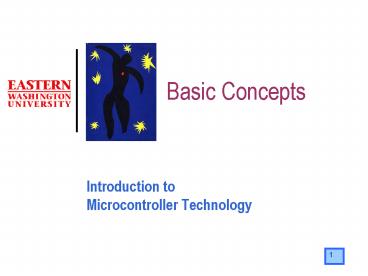Basic Concepts - PowerPoint PPT Presentation
1 / 26
Title:
Basic Concepts
Description:
WDT: Watch Dog Timer (automatic reset) AIO: Analog I/O (ADC & DAC) 14. Memory basic concepts ... The 68HC11 is a family of 8 bit microcontroller (MCU) ... – PowerPoint PPT presentation
Number of Views:243
Avg rating:3.0/5.0
Title: Basic Concepts
1
Basic Concepts
- Introduction to Microcontroller Technology
2
What is a Computing System ?
- Hardware Software
CPU
communication bus
3
What is a Microprocessor ?
Pentium 4 microphotograph
4
Inside the Microprocessor
5
Microprocessor Basic Operation
- Program (instructions) and Data are stored in
Memory - Each instruction is read (fetched) from memory,
interpreted (decoded), and executed - Arithmetic Logic Unit (ALU) performs operations
on data - Data is transferred (register, memory, I/O)
- Program Counter (PC) indicates current location
of program in Memory and is automatically
incremented after each instruction - Each instruction can take several clock cycles
6
What is a Microcomputer System ?
- It is a computing system based on
microcontroller.
7
Microcontroller System
- The buffers and converters condition I/O signal
levels if necessary - The bus is a group of signals (data, address,
control signal) with a common purpose. - The clock circuit generates a fixed-frequency,
timing signal for the entire system. - The power supply converts a raw power source into
the DC voltage (nominally 5V) required by the
system.
8
An example of microcontroller system(MC68HC11EVBU
evaluation board)
9
Microcontroller
- Integrated system designed to operate as an
embedded computing system ( a computer which is
part of a larger system) - It is composed by
- microprocessor (CPU),
- ROM (for the program),
- RAM (for the data)
- I/O ports (to communicate/interface with external
resources), - Peripheral devices (to make easier the
interfacing and implementation of the desired
functionalities),
10
Common Applications
- Consumer
- Washing machine,
- Remote controls
- Clocks and watches
- Games and Toys
- Audio/video
- Communication
- Telephone systems,
- Answering machines
- Cell phones and pagers
- Networking (ATM, credit cards, Ethernet)
- Automotive
- Safety devices (Automatic Braking System, Airbag)
- Motor control (ignition, exhausts)
- Power windows and seats
- Instrumentation
11
Common Applications
- Military
- Guidance systems
- Global positioning systems
- Target recognition systems
- Industrial
- Traffic control
- Robotics
- Production plants
- Inventory and stock management
- Medical
- Cardiac monitors
- Renal Monitors
- Pacemakers
- Dialysis machines
12
Microcontroller Organization
13
Microcontroller Functional Units
- CPU Central Processing Unit (4,8,16,32 bit data
bus) - ROM Read Only Memory (Firmware)
- RAM Random Access Memory (Register File,
Processor Stack, Temporary data) - PIO Parallel I/O (relays, sensors)
- INT Interrupt Inputs (external/internal
sources) - UART Universal Asynchronous Receiver Transmitter
(e.g. RS232) - GPT General Purpose Timer (optional event
counter) - PWM Pulse Width Modulator (motor controller)
- WDT Watch Dog Timer (automatic reset)
- AIO Analog I/O (ADC DAC)
14
Memory basic concepts
- Digital data is stored in the form of binary
numbers, however it is often represented using
the hexadecimal numbering system. - The bit is the smallest digital unit, and is
either 1 or 0. - A byte is defined to be 8 bits.
- A word varies from processor to processor and can
be 8, 16, 32 or more bits. - Normally, the byte is the smallest addressable
unit however, it is possible to address
individual bits in I/O registers. - Motorola convention binary number are prefixed
by and hexadecimal numbers by
15
Memory basic concepts
16
Memory Types
- The main types of semiconductor memory are
- ROM Read Only Memory
- RAM Random Access Memory
- EPROM Erasable Programmable Read Only Memory
- EEPROM Electrically Erasable Programmable
Read Only Memory
17
The Bus
- The bus provides the communication infrastructure
among the various components of the system - Data bus carries the information being
transmitted/received. - Address bus tells where the information is being
transferred to/from. - Control bus specifies when the information
transfer take place by coordinating the access to
the data bus and the address bus, and directs the
data from/to the specific components.
18
Motorola 68HC11
- The 68HC11 is a family of 8 bit microcontroller
(MCU). - The chip used in this class is MC68HC11E1CFN2
19
68HC11E1 Features
- 8-bit CPU
- Power Saving STOP and WAIT Modes
- Low-Voltage Devices Available (3.0-5.5 Vdc)
- 512 Bytes of On-Chip RAM, Data Retained During
Standby - 512 Bytes of On-Chip EEPROM
- Asynchronous Non-return to Zero (NRZ) Serial
Communications Interface (SCI) - Synchronous Serial Peripheral Interface (SPI)
- 8-Channel 8-Bit Analog-to-Digital (A/D) Converter
- 16-Bit Timer System
- Three Input Capture (IC) Channels
- Four Output Compare (OC) Channels
- One Additional Channel, Selectable as Fourth IC
or Fifth OC
20
Comparison between A and E series
21
68HC11E Pin Assignments
22
68HC11E block diagram
23
Memory Map
- A memory map is a graphical way of showing how
the memory space of the microcontroller is
divided. The map indicates the type (RAM, ROM,
etc.), size and boundaries of each part of the
memory space. - NOTE 1 KB 1024 (210) bytes of memory.
- The 68HC11 uses a 16-bit address, which means it
can directly address 216 (65,536) memory
locations.
24
Memory Map of the MC68HC11E1
25
68HC11E1 operating modes
26
68HC11 CPU Registers
- CPU registers are used solely to perform
general-purpose operation such as arithmetic,
logic and program flow control. - CPU registers do not occupy the 68HC11 memory
space.






























